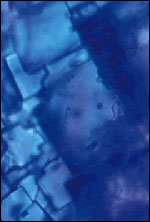|
Meteoritic visitors not only gouge huge craters in Earth's surface, they also carry with them material from elsewhere in the solar system. For example, a piece of Mars (below right), has been carefully preserved and thin slices apportioned to researchers who hope to learn whether tubelike structures seen under the microscope may be fossils of primitive organisms. A meteor that landed in 1998 in West Texas was found to contain blue and purple halite (right), a crystal similar to table salt. Further analysis confirmed the presence of water inside the crystals. Radiation has darkened the crystals, which are estimated to be 4.5 billion years old--meaning that the briny water could predate the Sun and planets in our solar system.
Other clues to chemicals in the early solar system could come from a complex class of organic ring molecules called polycyclic aromatic hydrocarbons (below). Spectral analysis has revealed the presence of these compounds in interstellar space. |  At less than a tenth of an inch across, the briny crystals in the West Texas meteorite are the largest halite crystals ever seen in any extraterrestrial material. |  The structural basis of polycyclic aromatic hydrocarbons is the highly stable benzene ring, a hexagonal arrangement of six carbon atoms, each attached to a hydrogen atom (top). Cororene (above left) is one such molecule whose presence has been inferred from spectral signatures. Though not yet formally identified in space, an even more stable configuration, the fullerene (above right) may have been the first object with a surface to form after the Big Bang. Fullerenes would be strong enough to survive impact with other molecules and go on to build dust, comets, asteroids, and planets. Some types of hydrocarbons found in ALH 84001 (right) are considered candidates for prebiological organic molecules. | Labeled ALH 84001, this 4.5-billion-year-old rock was once part of Mars. It is a piece of a meteorite that landed in Antarctica 13,000 years ago after having been dislodged from Mars by a high-energy impact about 16 million years ago. Although the rock's dryness does not strengthen the case for a water-rich crust on Mars, scientists hope to determine whether it contains fossil evidence of primitive life that may have once existed on the Red Planet.  |
To stretch the notion of a habitable zone to its extreme, consider what might happen if an Earth-like planet is ejected from its orbit around a star. Studies suggest that such ejections may be common. Jupiter-sized planets are gravitational bullies; they can fling their smaller brethren into deep space as casually as a flick of the wrist can snap a whip. According to calculations, those interstellar wanderers could retain their atmospheres. Thick atmospheres would trap warmth from the radioactive decay of elements and from volcanic activity on some of the planets. Those sources of heat could keep the oceans liquid, even without sunlight. The fascinating consequence is that life could persist on the seafloors of such nomadic worlds for billions of years.
Clearly, there are many niches in the universe in which life could arise. This offers some hope that the first few fractions in the Drake equation--the ones involving the likelihood of planets and life--have reasonably high values. But what of intelligent life? That's a tougher question to tackle. Here, our methodical consideration of matter and energy doesn't help. Some researchers argue that, given enough time, the progression from primitive life forms to intelligence is inevitable. Others observe that billions of species of life in Earth's history have led to just one society capable of beaming signals across space. And then there is the last factor in the Drake equation: the average lifetime of such a civilization. If other technological societies last only a century or so before self-destructing--as we nearly have upon occasion--the galaxy will contain few of them at any one time. But if they manage to survive for millions of years or longer, our Milky Way could be a haven for advanced aliens.
If any of these societies wanted to communicate, we presume that radio waves would be their band of choice in the electromagnetic spectrum. Radio signals are easy to create, and large radio telescope dishes can beam them on tight searchlight cones into space. Most important, radio waves traverse the galaxy unimpeded by interstellar gas and dust. Several groups of astronomers are systematically training their radio telescopes on nearby stars to try to pick up such signals. Their projects are collectively called the Search for Extraterrestrial Intelligence, or SETI. The most advanced efforts use powerful electronic detectors that can monitor billions of narrow radio channels at once, sifting for signals that rise above the cosmic din.
It seems that we Earthlings are primarily in "receive" mode when it comes to SETI. We rely upon other civilizations to beam greetings (or some other message) to us. But if (continued) |

